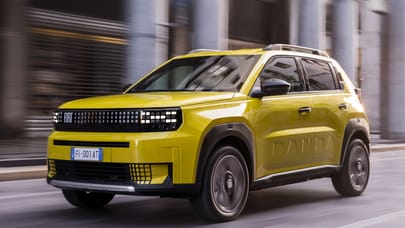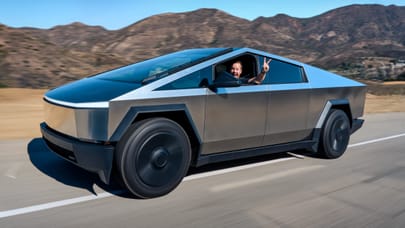
These are the 12 most aerodynamically efficient EVs on sale today
Electric cars are taking the art of reducing drag to new levels...

Lucid Air – 0.197

The crown for the slipperiest of them all goes to Silicon Valley-based Lucid with its Air electric saloon. Its clean-cut profile contributes to an astonishing 520-mile range, which also makes it the longest range EV in the world. There are worse records to have, that’s for sure.
Heading up the team of engineers charged with ensuring the Air cuts through the air as cleanly as possible is one Jean-Charles Monnet, Red Bull Racing’s former aerodynamicist, who’s seemingly succeeded in transferring all his previous Formula One know-how from racetrack to road.
While we’re still waiting on any Airs to reach our shores, we have had a go stateside, and found it mighty impressive indeed. We are told it’s still coming, so without further ado…
Advertisement - Page continues belowMercedes EQS – 0.200

Mercedes has got form when it comes to slippery streamliners – see the IAA and EQXX concepts – so an entrant on this list was inevitable. Cue the Mercedes EQS.
The first purpose built EV from the German brand (previously it had replaced its existing cars’ engines with the electric gubbins) features several details to optimise airflow including a smooth underbody, active radiator shutter and cooling air control system. A range of up to 453 miles speaks for itself, with the EQS able to cut through the air like a hot knife through butter.
At the time of its introduction back in 2021 it was the most aerodynamic car in production, though its drag co-efficient of 0.2Cd is only good enough for a silver medal today.
Nio ET7 – 0.208

You might remember Chinese electric car manufacturer Nio for its EP9 hypercar, but it’s also known in its homeland for its posh electric SUVs. Now, it’s branching out into saloons too – and its first, the ET7, boasts mighty impressive headline figures indeed.
We’re talking a drag coefficient of 0.208. A ginormous 150kWh battery. A monstrous range of around 650 miles (though that’s using China’s NEDC testing protocol), with the marque having recently completed a 648-mile journey on a single charge. Worried yet, Lucid?
Nio also has a network of battery swap stations in China, which allows owners to switch their depleted battery pack with a fully charged one in a matter of minutes. With the firm slowly but surely increasing its European presence, we expect to see it make its way to the UK at some stage too.
Advertisement - Page continues belowTesla Model S – 0.208

It’s testament to Tesla’s original design that for a car launched back in 2012, the year that saw Queen Elizabeth II celebrate her Diamond Jubilee, the Olympics come to London, and Barack Obama re-elected President for a second term in America, it retains its place on this list today. Advancements in technology, combined with the growth in the number of EVs on our roads, mean that this is an achievement that shouldn’t be understated.
“The lowest on the planet”, as the company claims of the Model S’s drag coefficient on its website, might be a little wide of the mark these days, but various aero enhancements, and presumably a monstrous amount of time spent in the wind tunnel, have seen its original 0.24Cd rating improved to 0.20Cd. Mock the frog-like styling all you like, but you can’t knock the results.
Hyundai Ioniq 6 – 0.21

Hyundai’s on a bit of a roll these days and the Ioniq 6 looks set to continue that trend, with the automotive and aeronautical worlds cited as inspiration behind its slippery streamlined shape.
These include the 1947 Stout Scarab, Phantom Corsair and Saab Ursaab streamliners, along with the Supermarine Spitfire and peregrine falcon. Yep, the 6’s rear spoiler winglets, which absorb the air flow from the roof and reduce drag, are reportedly inspired by the World War II British fighter plane, while the peregrine falcon’s shape while diving after prey was also studied. That’s a new one.
Unsurprisingly there’s active aero work at play too, while the 6 also faced 124mph speeds in the wind tunnel, all of which contribute to 100km (62 miles) further per charge over the Ioniq 5.
Lotus Emeya – 0.21

The Lotus Emeya is the Hethel firm’s first four-door hyper GT, and follows on from its Eletre SUV as the second of four electric cars in the upcoming pipeline by the brand.
So, its shape already lends itself to a low drag coefficient, but there’s much more at play here too. Namely, active aerodynamics, including an air dam under the front bumper and rear spoiler, which help to increase downforce and stability when deployed and reduce drag when not.
It all contributes to downforce of 150kg at 250km/h (155mph), and a low drag coefficient of 0.21Cd. Sure, it might not be a Lotus as we know it, but it’s the future face of the brand.
BYD Seal – 0.219

The third fully electric model from Chinese firm BYD – aka Build Your Dreams – to make it to the UK is this, the Seal, a rather (at least to our eyes) suave looking sports saloon.
And maximising range matters here. Which means minimising drag does too. BYD claims that its 2,920mm wheelbase and 1,460mm height gives it a perfect 1:2 “golden ratio”, with its low-to-the-ground body allowing it to “slice through the wind”. Mostly marketing spiel, but you get the gist.
The end result is a 354-mile range and 0.219 drag coefficient. But is it enough to convince you over the likes of the BMW i5, Tesla Model 3 or Hyundai Ioniq 6? Click the blue words below…
Advertisement - Page continues belowPorsche Taycan – 0.22

Porsche’s first all-electric car is a cracker – handsome to look at, great to drive, and up there amongst the very best for aerodynamic efficiency.
Indeed, Porsche claims its 0.22Cd drag coefficient is the lowest of any Porsche model, a figure achieved through extensive 3D CFD simulations, around 900 hours in the wind tunnel as a 1:3 model, and then another 1,500 hours in the wind tunnel once full scale.
Aerodynamic measures include air curtains around the front headlights, aero blade wheels, flat underbody panelling and a wide rear diffuser, while there’s also much active aero cleverness in the form of cooling air intakes and a three-way adjustable spoiler. Did you expect anything less?
XPeng P5 – 0.223

Another day, another Chinese electric car startup aiming to break Europe and eventually the UK. The P5 is the third electric car from Xpeng, following on from the G3 SUV and the P7 saloon, and it’ll come as no surprise that it’s yet another slippery saloon in the mould of the BMW i5, Hyundai Ioniq 6 and Tesla Model 3. Little surprise that all three also find themselves on this list.
While it first launched in China in 2021, a year later the order book opened in Denmark, Netherlands, Norway and Sweden. European spec cars get a single electric motor driving the front wheels, with 208bhp and 229lb ft of torque and up to 289 miles of range from the 66kWh battery. We’ve no confirmed UK arrival date yet, but we expect we won’t have long to wait.
Advertisement - Page continues belowBMW i5 – 0.23

The BMW i5 isn’t just one of the most aerodynamically efficient EVs on sale today, it’s one of the best electric cars on sale today full stop. But there’s also some extremely clever tech at play too.
Take the front air flap, which only opens as required, to increase range by 16 miles. The air curtains, meanwhile, direct the airflow past the front wheels, increasing range by up to 1.25 miles, while the specially designed lightweight alloys themselves increase the electric range by up to six miles. Then there’s the sealed underbody and aerodynamically shaped diffuser, which help to optimise the airflow under the car and increase the electric range by up to six miles.
Combined, you get a car that manages up to 356 miles of range from a single charge, aided by a drag co-efficient of just 0.23. But this is a car that’s so much more besides…
Tesla Model 3 – 0.23

The Model 3 has shown no sign of slowing down since we named it our saloon of the year back in 2019, becoming the first electric car to pass the one million global sales milestone in 2021, and the current holder of the bestselling electric car in world history.
Designed to be accessible to all, simple to operate and offer a handy real-world range aided by its low drag efficiency rating of 0.23Cd, these days it’s simply a household name. And let’s not forget Tesla’s cracking global charging infrastructure, which puts everyone else to shame.
It’s not hard to see why the Model 3 has become a global standard-setter for EVs. It’s biggest challenger, in fact, probably comes from within…
Tesla Model Y – 0.23

Yep, the Model Y was not only the best-selling electric car in the UK in 2023, but the best-selling car worldwide full stop, with over 1.2 million examples sold helping it knock the Toyota RAV4 off top spot. Seems there really is no stopping Elon these days. Apart from perhaps a Twitter poll.
A Model 3 in a more practical shape, it shares 75 per cent of its parts with its sibling, with the Model Y otherwise having had a slight growth spurt. Not that that seems to have had any impact on the drag coefficient, with an identical 0.23Cd shared between the two.
That extra weight, however, has resulted in a slight range penalty, with 331 miles playing 390 miles in the Long Range AWD Model Y and Model 3 variants respectively, plus an extra £3k asking price.
Trending this week
- Long Term Review
- Car Review








